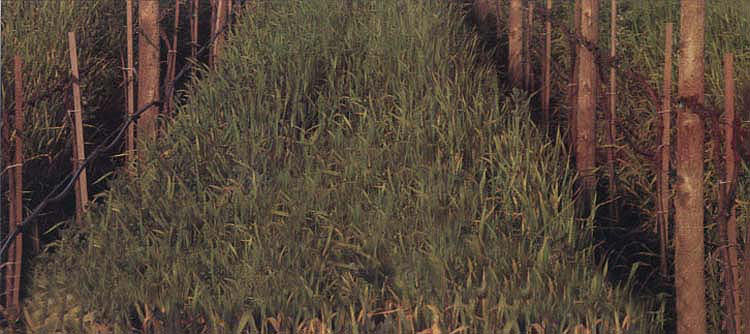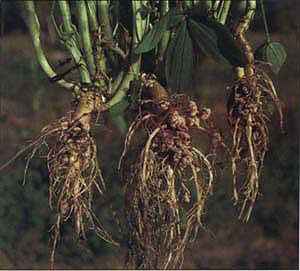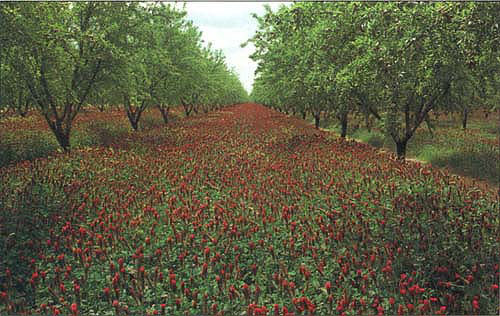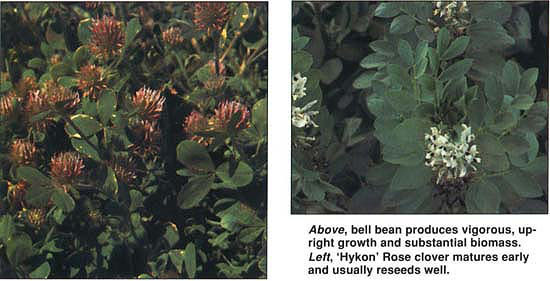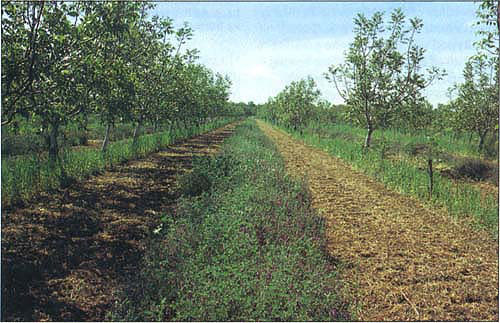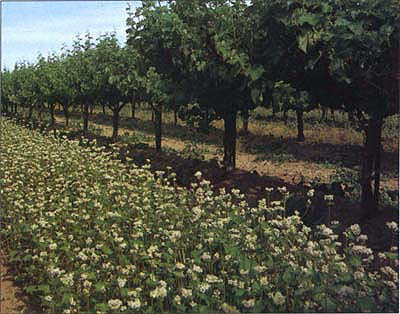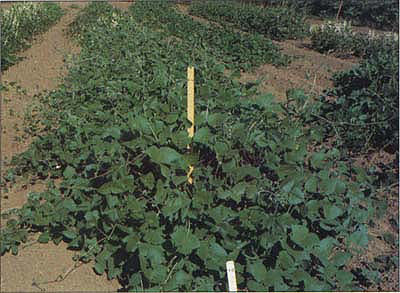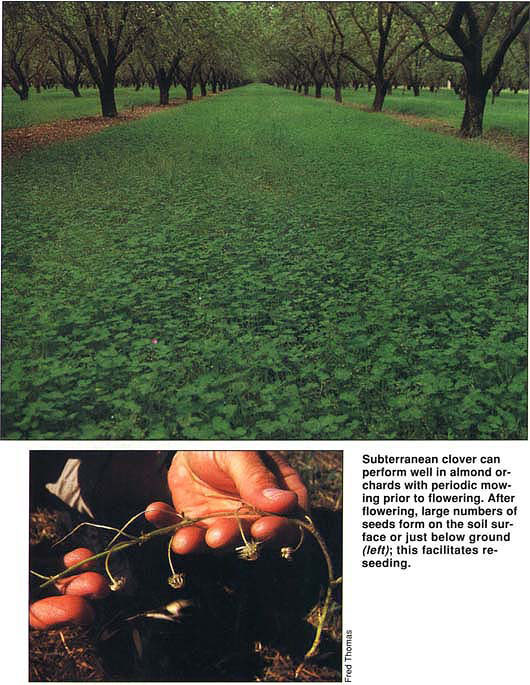All Issues
Selecting the right cover crop gives multiple benefits
Publication Information
California Agriculture 48(5):43-48.
Published September 01, 1994
PDF | Citation | Permissions
Abstract
The use of cover crops continues to increase as farmers seek to improve soil quality and reduce chemical inputs. Research and grower experience have shown that cover crops can provide multiple benefits related to soil protection, soil fertility, groundwater quality and pest management. Choosing the right cover crop is critical to successful cover cropping.
Full text
Above top: In vineyards with nitrogen-rich soils, grass cover crops such as barley can be used to reduce excessive vine vigor.
Above bottom: Nitrogen-fixing Rhizobium bacteria live in nodules on legumes, such as berseem clover shown here.
Cover crops were frequently used on California farms in the first half of this century, but were rarely grown after the 1950s, when pesticides and fertilizers came into widespread use. In the last decade, however, farmers and researchers have taken a renewed interest in cover crops because of their potential role in reducing chemical inputs and improving soil quality. Cover crops are now recognized as an important component of “sustainable” production in most areas of California.
Cover cropping can have both advantages and disadvantages (see sidebar, page 46). Proper choice and management of cover crops are important in maximizing the benefits and reducing potential problems. To select a species or mix, the grower should first determine the primary benefits he or she desires. Then consider the specific conditions of the particular farming system, such as soil type, water availability and method of irrigation, cropping sequence and cultural practices. There may be only a few species or many that are appropriate to a given farming system (see table 1).
Adding and conserving nitrogen
A common reason for growing cover crops is to add nitrogen to the soil using nitrogen-fixing legumes. Winter annual legumes can fix 100 to 200 pounds of nitrogen per acre. Many growers use a vetch, such as ‘Lana’ woollypod vetch, to add the greatest quantity of nitrogen. Summer annual legumes, such as cowpea, typically add 100 to 130 pounds of nitrogen. However, they can do so in 2 to 3 months, as compared to the 5- to 6-month growing season for most winter annual cover crops.
When a legume cover crop is incorporated into the soil, a substantial amount of nitrogen is usually mineralized (converted from organic to plant-available forms) within a few weeks. Nitrogen continues to mineralize in ensuing weeks as the organic matter decomposes. In nontillage systems, cover crops are mowed and the residues left on the soil surface. In such systems decomposition and nitrogen availability will usually be delayed. Nitrogen availability may also be reduced due to volatilization of nitrogen into the atmosphere from decomposing residues. Little information is available regarding such volatilization losses under California conditions; research is needed to determine the magnitude of such losses and the factors which affect them.
Most nonlegumes do not fix nitrogen, but they can affect soil nitrogen availability. Grasses can take up large quantities of nitrogen from the soil, thereby reducing the potential for nitrate leaching. Because of the high carbon-to-nitrogen (C/N) ratio of grasses, their residues decompose slowly, and soil nitrogen availability may be substantially decreased following their incorporation into the soil. Several species in the mustard family and tansy phacelia also take up nitrogen readily. Due to lower C/N ratios, however, these species decompose and release their absorbed nitrogen into the soil more rapidly than grasses (see California Agriculture, September-October 1993).
Showy crimson clover flowers stand above other mowable clovers in a mix suitable for almond orchards.
Above, bell bean produces vigorous, upright growth and substantial biomass. Left, ‘Hykon’ Rose clover matures early and usually reseeds well.
Some orchardists allow a portion of the cover crop to persist and mature in remnant bands. This practice offers the benefits associated with early mowing or disking, and allows reseeding of the entire understory when the band is mown in early summer.
Water use by cover crops
All cover crops require water for growth, but in most parts of California winter cover crops have relatively little impact on soil moisture. However, the earlier the cover crop is sown in the fall or the longer it is allowed to grow in the spring, the more water it will use. Summer annual cover crops use more water than winter annuals and require irrigation. However, some species, such as cowpea and hyacinth bean, are relatively drought tolerant and can perform well with as little as two irrigations (J. Klein and M. Van Horn, unpublished data).
In orchards and vineyards, summer-active cover crops (for example, perennial clovers) compete directly with the cash crops for water. A 4-year study of almonds grown in Merced and Stanislaus counties showed that both resident vegetation and strawberry clover used 20 to 25% more water than a bare floor in a mature orchard (see California Agriculture, July-August 1989). ‘Blando’ brome (soft chess) used more water than the bare floor treatment during the spring. However, its clippings acted as a mulch, reducing evaporation from the orchard floor in the summer and offsetting earlier water use. Certain California native perennial grasses are summer dormant and therefore use little or no water during the summer, especially where drip irrigation is used. Some of these grasses are being tested in vineyards and have potential value in orchards as well. It is important to note that soil improvements by cover crops may lead to more efficient use of water, especially on sandy soils.
Pest management
Cover crops can also aid in pest management. For example, some cover crops compete with and suppress weeds. Competitive cover crop species include many perennials, such as strawberry clover, and annuals with relatively large seeds and good seedling vigor, such as cereal grasses, vetches and cowpea. Some other species, such as annual clovers and small-seeded grasses, may not compete well if left unmanaged, especially on very fertile soils. With well-timed mowing or grazing, however, they regrow rapidly, often more so than competing weeds.
Some cover crop species can become serious weeds if improperly selected or managed. For example, most vetches produce substantial viny growth, which can, if planted near tree or vine rows, overtake grapevines or entwine sprinklers. Also, certain species, such as cereal rye, produce tremendous amounts of biomass, which can hinder mowing and disking. Other species, such as perennial clovers, may invade tree or vine rows and resist herbicides; perennial clovers also have a reputation for increasing gopher populations.
Hardseededness is a characteristic of certain cover crop species that can help ensure self-regeneration of a cover crop stand. Hard seeds have seed coats that are impermeable to water, ensuring that a portion of the seed bank is held in reserve each year. These seeds are viable, but will not germinate in the first year after they mature. Thus, once a cover crop with hard seeds is planted, it can be expected to reestablish itself with fall rains each year, even in years when the previous cover crop did not produce seed. Rose clovers produce high proportions of hard seed, as do medics and some vetch species and subterranean clover varieties. Self-regenerated stands are usually desirable in orchards and vineyards, but these species may become problem weeds in annual systems.
Potential benefits of cover crops
-
Protection of soil from water and wind erosion
-
Addition of organic matter to soils
-
Improvement of soil structure and water penetration
-
Addition or conservation of nitrogen
-
Suppression of weed growth
-
Attraction and sustenance of beneficial insects, spiders and mites
Potential disadvantages of cover crops
-
Depletion of soil moisture
-
Temporary decrease in availability of plant nutrients, especially nitrogen
-
Increased weed problems
-
Attraction of arthropod or rodent pests
-
Increased danger of frost damage to tree or vines
-
Increased associated costs
Cover crops in vineyards and orchards may provide food or shelter to beneficial insects, mites and spiders. In citrus, for example, the predatory mite Euseius tularensis is a key predator of citrus thrips and various other pests. As Ouyang, Grafton-Cardwell and Bugg observed in 1993, in the absence of prey, this predatory mite can also subsist for a time on windblown pollens of grasses commonly used as cover crops. Field trials are still needed to determine whether grass cover crops lead to improved biological control of the pests mentioned.
Cover crops such as soft chess, ‘Salina’ strawberry clover and resident vegetation speed up the decomposition of unharvested almonds remaining on the orchard floor after harvest. Left intact, these nuts would provide overwintering habitat for navel orangeworm. Decomposition is aided by the moisture in cover crops and by flail mowing, greatly decreasing spring emergence of the moths from almonds (see California Agriculture, July-August 1989). Navel orangeworm emergence from walnuts remaining in a tall winter cover crop may not differ significantly from those remaining on herbicide-treated soil (see California Agriculture, September-October 1993).
Some pest arthropod species are also associated with cover crops and may require management. For example, two ant species — pavement ant and southern fire ant — damage almonds by feeding on the kernels of nuts that have been shaken to the ground. The ants are more damaging in orchards cover cropped with soft chess, strawberry clover and resident vegetation than in orchards treated with residual herbicide (see California Agriculture, July-August 1989). In cover-cropped orchards, prompt pickup of fallen nuts is important to avoid problems with ants.
Some leguminous cover crops harbor abundant lygus bugs, which are pests of some tree crops. However, studies in southern Georgia by Bugg and others in 1990 suggest that subterranean clovers harbor very few lygus bugs compared to vetches, medics and other clovers; our own observations in California confirm this.
Cover crops in annual rotations
In annual cropping systems, cover crops are often chosen to maximize benefits such as biomass and nitrogen production. However, other factors must also be considered. For example, fitting a cover crop into the sequence of a crop rotation can be difficult. Therefore, fast-growing, drought-tolerant cover crops that require minimal management are preferred. Cover crops with fast germination and good seedling vigor are usually chosen because of their ability to compete with weeds. Also, species with the potential to reduce pest populations should be chosen, while those that harbor diseases or arthropod pests of the cash crops should be avoided.
Common cool-season legumes used as cover crops in annual rotations include vetches, winter pea and bell bean. Because clovers and medics grow slower and compete poorly with weeds and require more management (e.g., mowing), they are used less commonly in annual rotations. For similar reasons, cereal grains are usually preferred over other grass species, such as bromes, in annual rotations.
In choosing warm-season cover crops, the ability to perform well with minimal irrigation is often of primary consideration. Legume species in this category include cowpea, hyacinth bean and sunnhemp. Typical grass cover crops for warm conditions include sudangrass and sorghum.
Above top, summer annual buckwheat flowers early and is used in some vineyards to attract a diversity of beneficial insects.
Above bottom, hyacinth bean is a recently introduced summer annual legume, which is viny and very heat and drought tolerant.
Self-reseeding cover crops
Many tree and vine crop growers prefer to use self-reseeding annual cover crops. Using these species can reduce or eliminate the costs associated with purchasing and sowing seed each year. Although many of these species compete effectively with weeds if properly managed, in some cases the reseeding cover may revert back to resident vegetation within a few years. It may be necessary to resow the cover crop in 3 to 5 years.
With some cover crops, self-reseeding can fail if insufficient moisture is available in the spring to mature the seed for the next year's cover crop. This problem will most likely occur if the row middles cannot be irrigated, such as when using drip irrigation. In these situations, it may be wise to choose cover crops that produce seed early in the spring and/or produce a relatively high proportion of hard seed. Early-maturing varieties of crimson clover, subterranean clover and burr medic are commercially available. Early-maturing grasses include ‘Zorro’ fescue and ‘Blando’ brome.
Conclusion
Successful cover cropping requires the selection of a species or mix that will provide specific desired benefits and that will be compatible with the overall farming system. Most growers who use cover crops derive multiple benefits from them. In many situations, a successful cover crop stand and the greatest benefits can be obtained by using mixtures of species, such as grasses and legumes. Furthermore, as with cash crops, cover crops should be rotated periodically to avoid the buildup of plant-specific pests.
Subterranean clover can perform well in almond orchards with periodic mowing prior to flowering. After flowering, large numbers of seeds form on the soil surface or just below ground (left); this facilitates reseeding.
Cover cropping, like any new practice, should be approached slowly and methodically. It may be valuable to test several species or mixtures to find the most appropriate cover crop. It is usually a good idea to begin on a small scale in order to learn from mistakes without incurring unnecessary expenses. With persistence and creativity, cover cropping can provide many benefits with little or no extra cost.



